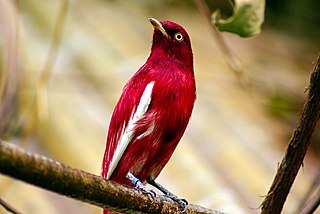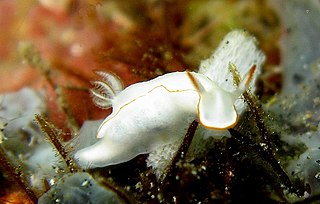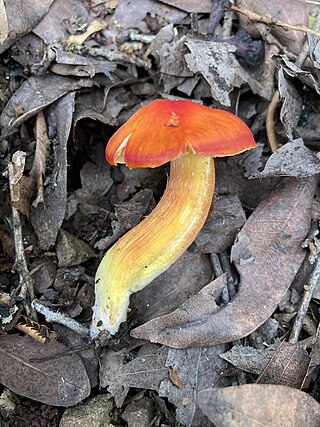
Hygrocybe punicea is a species of agaric in the family Hygrophoraceae. It has been given the recommended English name of crimson waxcap. The species has a European distribution, occurring mainly in agriculturally unimproved grassland. Threats to its habitat have resulted in the species being assessed as globally "vulnerable" on the IUCN Red List of Threatened Species. Records of H. punicea from North America, East Asia, and Australia require further research to see if they represent the same species.

Blandfordia punicea, commonly known as Tasmanian Christmas bell, is a species of flowering plant that is endemic to western Tasmania. It is a tufted perennial herb with linear leaves and drooping red, bell-shaped flowers that are yellow on the inside.

Regelia is a genus of flowering plants in the family Myrtaceae and is endemic to the south-west of Western Australia. The genus is composed of five species of small leaved, evergreen shrubs which have heads of flowers on the ends of branches which continue to grow after flowering. Another species, previously known as Regelia punicea and which is endemic to Kakadu National Park in the Northern Territory, has been transferred to Melaleuca punicea.

The pompadour cotinga is a species of bird in the family Cotingidae. This species lives in the Amazonian rainforest and has a range that extends across the Amazon Basin and includes Brazil, Peru, Colombia, Venezuela, and the Guianas. The pompadour cotinga is primarily a frugivore but has been known to consume insects on occasion. This species of cotinga is distinct in that the males have a burgundy head and body, bright white wings, and yellow eyes. Like other members of the Cotingidae, this species is sexually dimorphic and the females have a pale grey head and body. Although there are not many documented observations of the nesting behavior of these birds, the males are known to perform elaborate mating displays for the females who then raise the young alone.

Miltochrista is a genus of moths of the family Erebidae, subfamily Arctiinae. The genus was erected by Jacob Hübner in 1819.

Thorunna is a genus of sea slugs, dorid nudibranchs, shell-less marine gastropod mollusks in the family Chromodorididae.

Sesbania punicea is an ornamental shrub with reddish-orange flowers. It has deciduous leaves and grows to a height of 15 feet. This plant has a high demand for water, and thrives in swamps or wet areas. It requires a mildly acidic soil, with a pH between 6.1 and 6.5.
Hinemoa punicea is a species of sea snail, a marine gastropod mollusk in the family Pyramidellidae, the pyrams and their allies.
Turbonilla punicea is a species of sea snail, a marine gastropod mollusk in the family Pyramidellidae, the pyrams and their allies.

Tubaria punicea is a rare species of agaric fungus in the family Tubariaceae. It is found on the west coast of North America, where it grows on the bases and in hollows of madrone.
Striatochrista prominens is a species in the moth family Erebidae, found in southern Asia.
Striatochrista radians is a species in the moth family Erebidae.
Striatochrista zebrina is a species in the moth family Erebidae, found in southern Asia.

Moorasura inflexa is a species in the moth family Erebidae, found in the Himalayas in southern Asia.

Melaleuca punicea is a plant in the myrtle family, Myrtaceae, and is endemic to the Northern Territory in Australia. Some of the characteristics of this species make it difficult to classify at the genus level. After it was originally described in 1984 as Melaleuca punicea, it was transferred in 1986 to the genus Regelia but it did not fit well in that genus either. In 1999 it was transferred again to a new genus Petraeomyrtus as P. punicea. Subsequent molecular studies, especially of chloroplast DNA have suggested that it is best placed in Melaleuca along with others from genera including Beaufortia, Callistemon and Regelia. Later publications include this species as Melaleuca punicea.

Eremophila punicea, commonly known as crimson eremophila, is a flowering plant in the figwort family, Scrophulariaceae and is endemic to Australia. It is a small, bushy shrub with small grey leaves, hairy branches and attractive pink flowers growing in areas east of Geraldton.

Lycorma is a genus of planthoppers native to Asia. The first species within the genus was described by Frederick William Hope in 1843 and the genus was formally established by Carl Stål in 1863.

Paradiarsia punicea is a moth belonging to the family Noctuidae. The species was first described by Jacob Hübner in 1803.

Hygrocybe laetissima, also known as the cherry-red waxy cap, is a species of gilled mushroom found in North America. It appears to flourish in association with redwood forests. The authors of Mushrooms of the Redwood Coast note that this waxy cap is superficially similar to other waxy caps, including Hygrocybe splendidissima, Hygrocybe punicea, Hygrocybe aurantiosplendens, and Hygrocybe marchii. It also overlaps somewhat in range and appearance with Hygrocybe coccinea. This one has the coloration of a Rainier cherry. Not recommended as an edible mushroom because close cousins have made people sick. This mushroom species was first described by Alexander H. Smith and L. R. Hesler.













